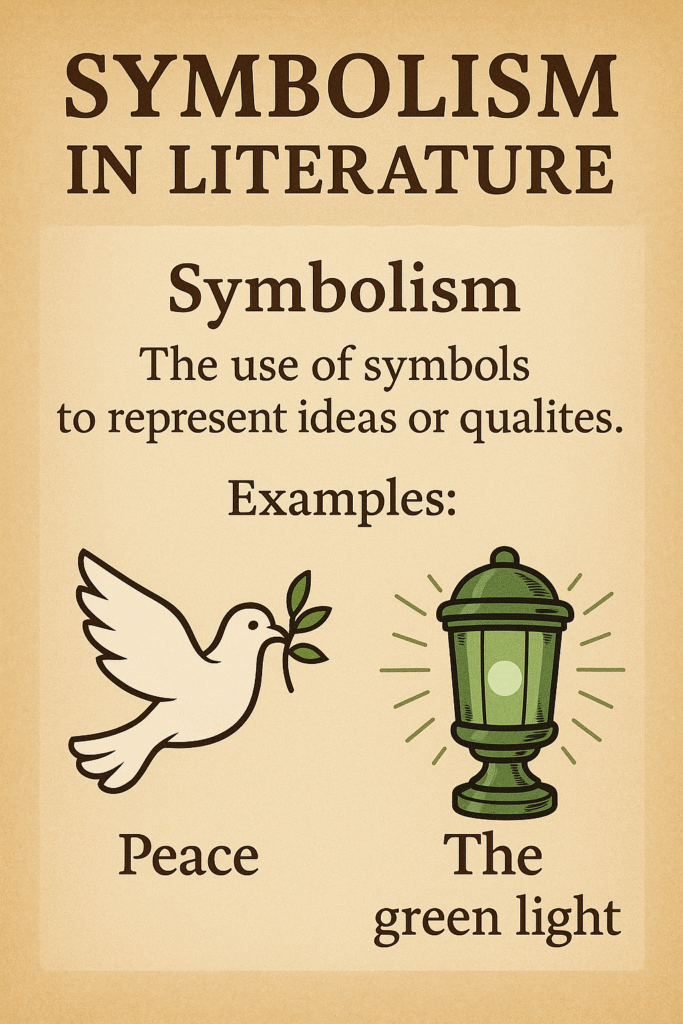Introduction: Unlocking Symbolism in Literature
Writers use symbolism to express complex ideas. They achieve this through objects, characters, or events. Writers use symbolism to give depth to their stories and to suggest themes and emotions without directly stating them. This literary device enhances the meaning of a text, making it rich, multi-layered, and emotionally compelling. In this article, we will explore the significance, uses, and effects of symbolism in literature, along with key examples.
Understanding Symbolism in Simple Words
Symbolism means using one thing to represent something else. It can be a person, object, place, or action that stands for a deeper idea. For example, a dove often symbolizes peace. This technique helps authors suggest powerful meanings without being too direct. Instead of saying “hope,” they might describe a sunrise. Instead of saying “death,” they may write about falling leaves.
Why Writers Use Symbolism in Literature
Writers do not always want to spell out every idea. Symbolism helps them speak in a silent but powerful language. It makes the story more interesting and emotional. It also allows readers to think and discover meanings on their own. As a result, symbolic literature becomes more memorable. Through symbols, writers connect the reader’s imagination to the story’s deeper messages.
Common Types of Symbols in Literature
Writers use both universal and unique symbols in their work. Below are some examples:
- Objects as Symbols:
- A rose = love or beauty
- A chain = unity or restriction
- A mirror = self-reflection or truth
- Nature Symbols:
- Storm = chaos or emotional disturbance
- River = life’s journey or time
- Fire = passion, destruction, or rebirth
- Colors as Symbols:
- Red = danger or passion
- White = purity or innocence
- Black = death, mystery, or evil
- Animals as Symbols:
- Owl = wisdom
- Snake = danger, betrayal, or transformation
- Lion = courage or power
How Symbolism Creates Depth in Writing
Symbolism adds layers of meaning to a story. A character holding a flower may seem simple. But if the flower is dying, it may suggest lost hope or fading beauty. Readers feel more connected because they interpret the story using emotions, ideas, and personal experiences. A strong symbol can represent many things at once, which is why readers often return to symbolic literature again and again.
Examples of Symbolism in Famous Works
- “The Great Gatsby” by F. Scott Fitzgerald
The green light across the bay symbolizes Gatsby’s hopes and dreams. It also represents the American Dream and its fading promise. - “Moby Dick” by Herman Melville
The white whale is a symbol of obsession, nature’s power, and the unknown. It holds different meanings for each character. - “Lord of the Flies” by William Golding
The conch shell represents order and civilization. As it breaks, so does the group’s sense of control. - “To Kill a Mockingbird” by Harper Lee
The mockingbird symbolizes innocence. To harm one is to harm someone who only brings goodness.
Symbolism vs. Allegory: A Quick Look
While both symbolism and allegory involve deeper meanings, they are not the same. An allegory is a whole story with a second meaning beneath the surface. In contrast, symbolism uses single items to suggest meanings. For instance, Animal Farm is an allegory, while the green light in The Great Gatsby is a symbol.
How to Spot Symbolism in a Text
Spotting symbolism requires attention. Readers must ask:
- Is this object mentioned more than once?
- Does it appear during emotional moments?
- Does the object seem to stand for something else?
If yes, then it is likely a symbol. Readers should then think about what it might mean in the story’s context.
Importance of Symbolism in Poetry and Drama
Undoubtedly, symbolism plays a big role in both poetry and drama. In particular, poets often use symbols to compress big ideas into just a few words. In fact, a single word or image can carry multiple layers of meaning. Likewise, in drama, symbolic actions and props help create emotional tension and reinforce themes without lengthy dialogue. For example, in Shakespeare’s plays, blood frequently symbolizes guilt and murder.
Symbolism in Modern Writing and Films
Even modern novels, movies, and shows use symbolism. For example, in Harry Potter, the scar on Harry’s forehead symbolizes pain, fate, and connection to the villain. In The Hunger Games, the mockingjay pin stands for rebellion and hope. These symbols make the stories more meaningful and emotionally rich.
The Role of Cultural and Historical Symbols
Some symbols change meaning across cultures. For example, white is purity in Western cultures, but it can mean mourning in others. Similarly, historical events give new meanings to symbols. A crown may symbolize royalty in one story and oppression in another. That’s why understanding cultural context helps in interpreting symbols.
Teaching Symbolism to Students
When teaching symbolism, start with simple examples. Use visuals, poems, or movie clips to engage students. Ask students to identify what they see and consider how it makes them feel. Encourage them to think beyond the surface. Once they understand simple symbols, they can move on to deeper literary examples. Overall, symbolism improves reading skills, creativity, and critical thinking.
Conclusion: The Lasting Power of Symbolism in Literature
Indeed, symbolism in literature turns simple objects into powerful messages. As a result, it deepens the reading experience and, at the same time, invites personal interpretation. From ancient myths to modern stories, symbols consistently speak across time and culture. Therefore, learning to recognize them helps readers connect deeply with texts. For this reason, symbolism remains one of the most beautiful and essential tools in literature.

————————————————————————————————————————————————————–
English Literature: http://englishlitnotes.com
American Literature: https://americanlit.englishlitnotes.com/thomas-paine-revolutionary-american-writer/
Grammar Puzzle Solved: https://grammarpuzzlesolved.englishlitnotes.com/category/grammar-puzzle-solved-by-naeem-sir/
Notes on English for All Classes: http://englishwithnaeemullahbutt.com
Discover more from Naeem Ullah Butt - Mr.Blogger
Subscribe to get the latest posts sent to your email.
